Business and Business Environment Analysis Report: NatWest
VerifiedAdded on 2020/07/23
|11
|3311
|93
Report
AI Summary
This report provides a comprehensive analysis of different business types, including public, private, and voluntary entities, and their respective purposes. It explores the significance of the business environment, focusing on the interrelation of corporation functions and divisions within an organization, using NatWest as a case study. The report delves into the impact of the macro environment on businesses, utilizing PESTLE analysis to assess political, economic, social, technological, legal, and environmental factors. Additionally, it employs SWOT analysis to determine the strengths, weaknesses, opportunities, and threats of the chosen firm, offering insights into strategic planning and operational effectiveness.
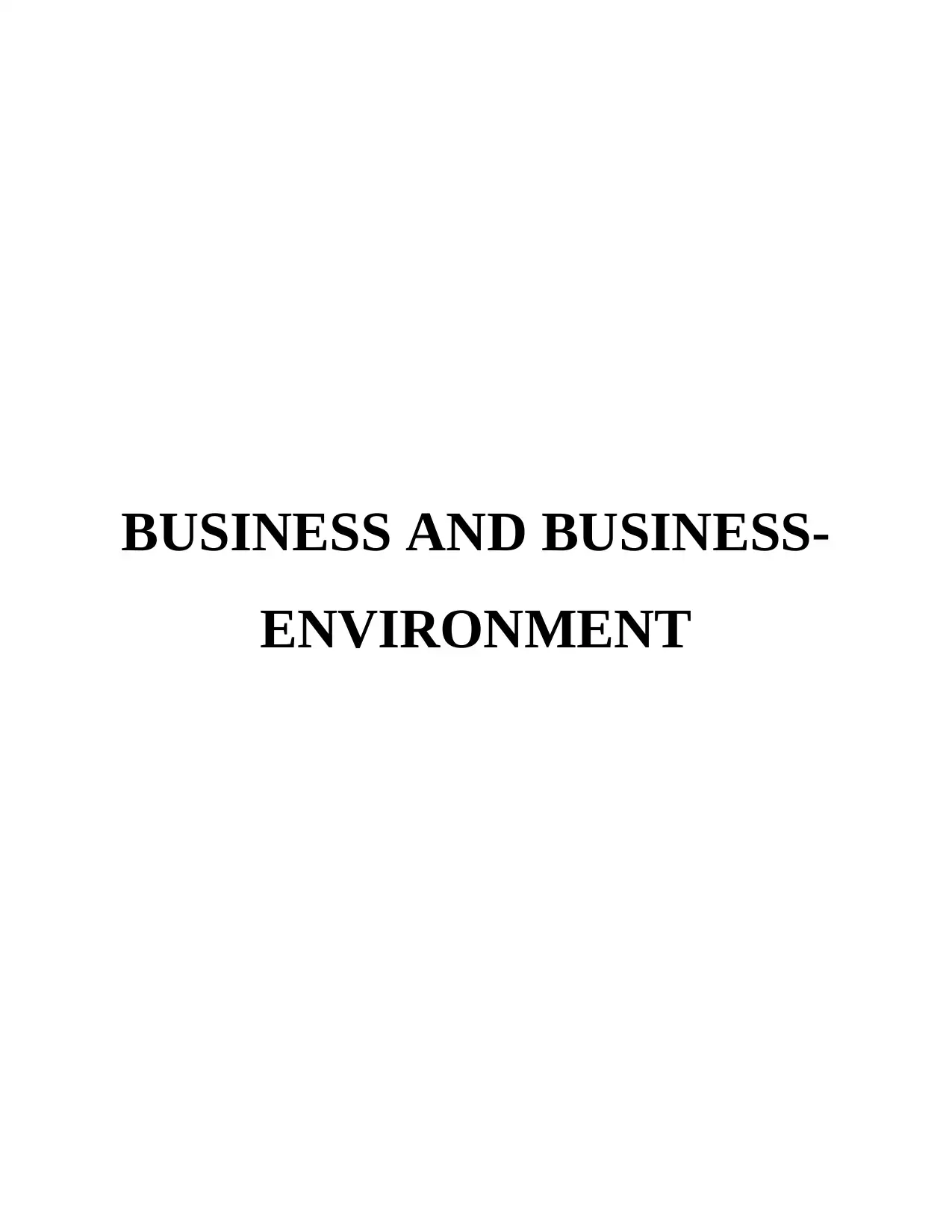
BUSINESS AND BUSINESS-
ENVIRONMENT
ENVIRONMENT
Paraphrase This Document
Need a fresh take? Get an instant paraphrase of this document with our AI Paraphraser

Table of Contents
INTRODUCTION...........................................................................................................................1
TASK 1............................................................................................................................................1
P1 Different types of business and their purposes..................................................................1
Task 2...............................................................................................................................................3
P2 Relationship between corporation functions and division and interlink to achieve
organisation objectives...........................................................................................................3
TASK 3............................................................................................................................................4
P3 Pestle analysis of chosen organisational...........................................................................4
TASK 4............................................................................................................................................6
P4 Swot tool to determine strengthen and weakness of chosen firm.....................................6
CONCLUSION................................................................................................................................7
REFERENCES................................................................................................................................8
INTRODUCTION...........................................................................................................................1
TASK 1............................................................................................................................................1
P1 Different types of business and their purposes..................................................................1
Task 2...............................................................................................................................................3
P2 Relationship between corporation functions and division and interlink to achieve
organisation objectives...........................................................................................................3
TASK 3............................................................................................................................................4
P3 Pestle analysis of chosen organisational...........................................................................4
TASK 4............................................................................................................................................6
P4 Swot tool to determine strengthen and weakness of chosen firm.....................................6
CONCLUSION................................................................................................................................7
REFERENCES................................................................................................................................8

INTRODUCTION
To bring the better perspective and effectiveness, Business and business environment
play an important role in the organisation. NatWest is an old banking firm which offers multiple
product line as retail banking, commercial banking, investment and wealth management. This
report will describe different types of corporations and their purpose. Along with this, it also
focuses on the relationship between organisation function and division to accomplish firm's
objectivities. At the end, report will explain the positive and negative impact of macro
environment on business and also describe the SWOT and PESTLE analysis of chosen company.
TASK 1
P1 Different types of business and their purposes
In order to make growth and future development of any country and nation is based on
the various organisation. Different corporations play a huge role in the development of country;
this is because they bring social welfare within the nation. There are different types of
organisations such as private, public, voluntary etc. (Drucker, 2017). These corporations have
different structure, different business environment but have a common aim that is to improve the
economy of country.
Public: In respect to run business, those enterprises that are run by government of the particular
country. They are charge taxes, rules, regulation, etc. that create impact on the functions and
operations of the business. This kind of sector generally produces goods and services such as free
educations and health care (Carroll and Buchholtz, 2014). Moreover, another examples includes
in this sector are road building service, equipment of parks etc. along with this it includes police
service, water supply, military, telecommunication etc. this corporation provides three types of
goods and services such as public, merit and essential. The example of public entity in UK is
Barclays.
Main motive of public firm: One of the most and big aim of public entity is to balance the
nation economy and social development by providing goods and services such as free
education, health care etc.(Welford, 2013).
Advantages: through the public sector government is able to increase leaving standard of
the people. Through the free education government of UK is trying to remove poverty
from the country.
1
To bring the better perspective and effectiveness, Business and business environment
play an important role in the organisation. NatWest is an old banking firm which offers multiple
product line as retail banking, commercial banking, investment and wealth management. This
report will describe different types of corporations and their purpose. Along with this, it also
focuses on the relationship between organisation function and division to accomplish firm's
objectivities. At the end, report will explain the positive and negative impact of macro
environment on business and also describe the SWOT and PESTLE analysis of chosen company.
TASK 1
P1 Different types of business and their purposes
In order to make growth and future development of any country and nation is based on
the various organisation. Different corporations play a huge role in the development of country;
this is because they bring social welfare within the nation. There are different types of
organisations such as private, public, voluntary etc. (Drucker, 2017). These corporations have
different structure, different business environment but have a common aim that is to improve the
economy of country.
Public: In respect to run business, those enterprises that are run by government of the particular
country. They are charge taxes, rules, regulation, etc. that create impact on the functions and
operations of the business. This kind of sector generally produces goods and services such as free
educations and health care (Carroll and Buchholtz, 2014). Moreover, another examples includes
in this sector are road building service, equipment of parks etc. along with this it includes police
service, water supply, military, telecommunication etc. this corporation provides three types of
goods and services such as public, merit and essential. The example of public entity in UK is
Barclays.
Main motive of public firm: One of the most and big aim of public entity is to balance the
nation economy and social development by providing goods and services such as free
education, health care etc.(Welford, 2013).
Advantages: through the public sector government is able to increase leaving standard of
the people. Through the free education government of UK is trying to remove poverty
from the country.
1
⊘ This is a preview!⊘
Do you want full access?
Subscribe today to unlock all pages.

Trusted by 1+ million students worldwide
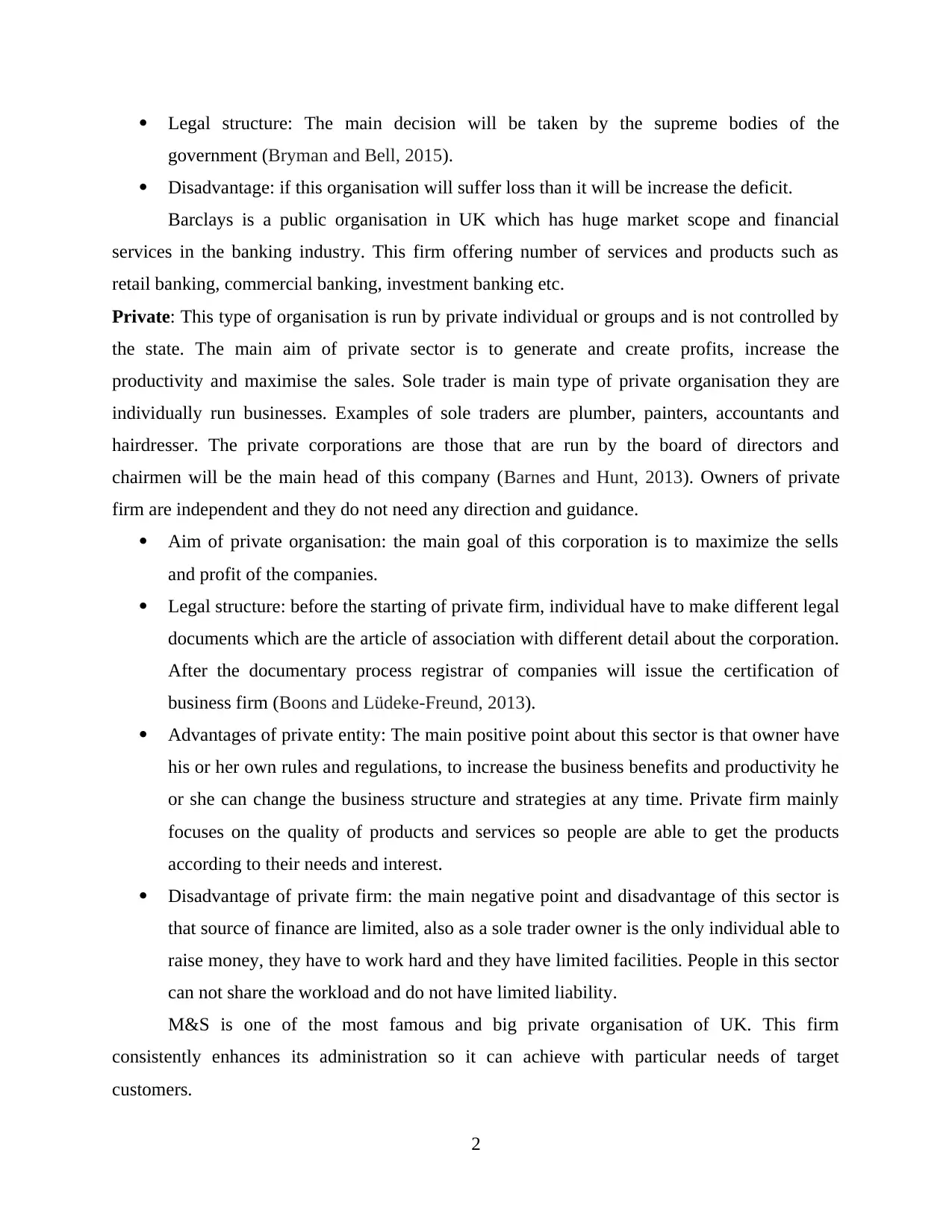
Legal structure: The main decision will be taken by the supreme bodies of the
government (Bryman and Bell, 2015).
Disadvantage: if this organisation will suffer loss than it will be increase the deficit.
Barclays is a public organisation in UK which has huge market scope and financial
services in the banking industry. This firm offering number of services and products such as
retail banking, commercial banking, investment banking etc.
Private: This type of organisation is run by private individual or groups and is not controlled by
the state. The main aim of private sector is to generate and create profits, increase the
productivity and maximise the sales. Sole trader is main type of private organisation they are
individually run businesses. Examples of sole traders are plumber, painters, accountants and
hairdresser. The private corporations are those that are run by the board of directors and
chairmen will be the main head of this company (Barnes and Hunt, 2013). Owners of private
firm are independent and they do not need any direction and guidance.
Aim of private organisation: the main goal of this corporation is to maximize the sells
and profit of the companies.
Legal structure: before the starting of private firm, individual have to make different legal
documents which are the article of association with different detail about the corporation.
After the documentary process registrar of companies will issue the certification of
business firm (Boons and Lüdeke-Freund, 2013).
Advantages of private entity: The main positive point about this sector is that owner have
his or her own rules and regulations, to increase the business benefits and productivity he
or she can change the business structure and strategies at any time. Private firm mainly
focuses on the quality of products and services so people are able to get the products
according to their needs and interest.
Disadvantage of private firm: the main negative point and disadvantage of this sector is
that source of finance are limited, also as a sole trader owner is the only individual able to
raise money, they have to work hard and they have limited facilities. People in this sector
can not share the workload and do not have limited liability.
M&S is one of the most famous and big private organisation of UK. This firm
consistently enhances its administration so it can achieve with particular needs of target
customers.
2
government (Bryman and Bell, 2015).
Disadvantage: if this organisation will suffer loss than it will be increase the deficit.
Barclays is a public organisation in UK which has huge market scope and financial
services in the banking industry. This firm offering number of services and products such as
retail banking, commercial banking, investment banking etc.
Private: This type of organisation is run by private individual or groups and is not controlled by
the state. The main aim of private sector is to generate and create profits, increase the
productivity and maximise the sales. Sole trader is main type of private organisation they are
individually run businesses. Examples of sole traders are plumber, painters, accountants and
hairdresser. The private corporations are those that are run by the board of directors and
chairmen will be the main head of this company (Barnes and Hunt, 2013). Owners of private
firm are independent and they do not need any direction and guidance.
Aim of private organisation: the main goal of this corporation is to maximize the sells
and profit of the companies.
Legal structure: before the starting of private firm, individual have to make different legal
documents which are the article of association with different detail about the corporation.
After the documentary process registrar of companies will issue the certification of
business firm (Boons and Lüdeke-Freund, 2013).
Advantages of private entity: The main positive point about this sector is that owner have
his or her own rules and regulations, to increase the business benefits and productivity he
or she can change the business structure and strategies at any time. Private firm mainly
focuses on the quality of products and services so people are able to get the products
according to their needs and interest.
Disadvantage of private firm: the main negative point and disadvantage of this sector is
that source of finance are limited, also as a sole trader owner is the only individual able to
raise money, they have to work hard and they have limited facilities. People in this sector
can not share the workload and do not have limited liability.
M&S is one of the most famous and big private organisation of UK. This firm
consistently enhances its administration so it can achieve with particular needs of target
customers.
2
Paraphrase This Document
Need a fresh take? Get an instant paraphrase of this document with our AI Paraphraser
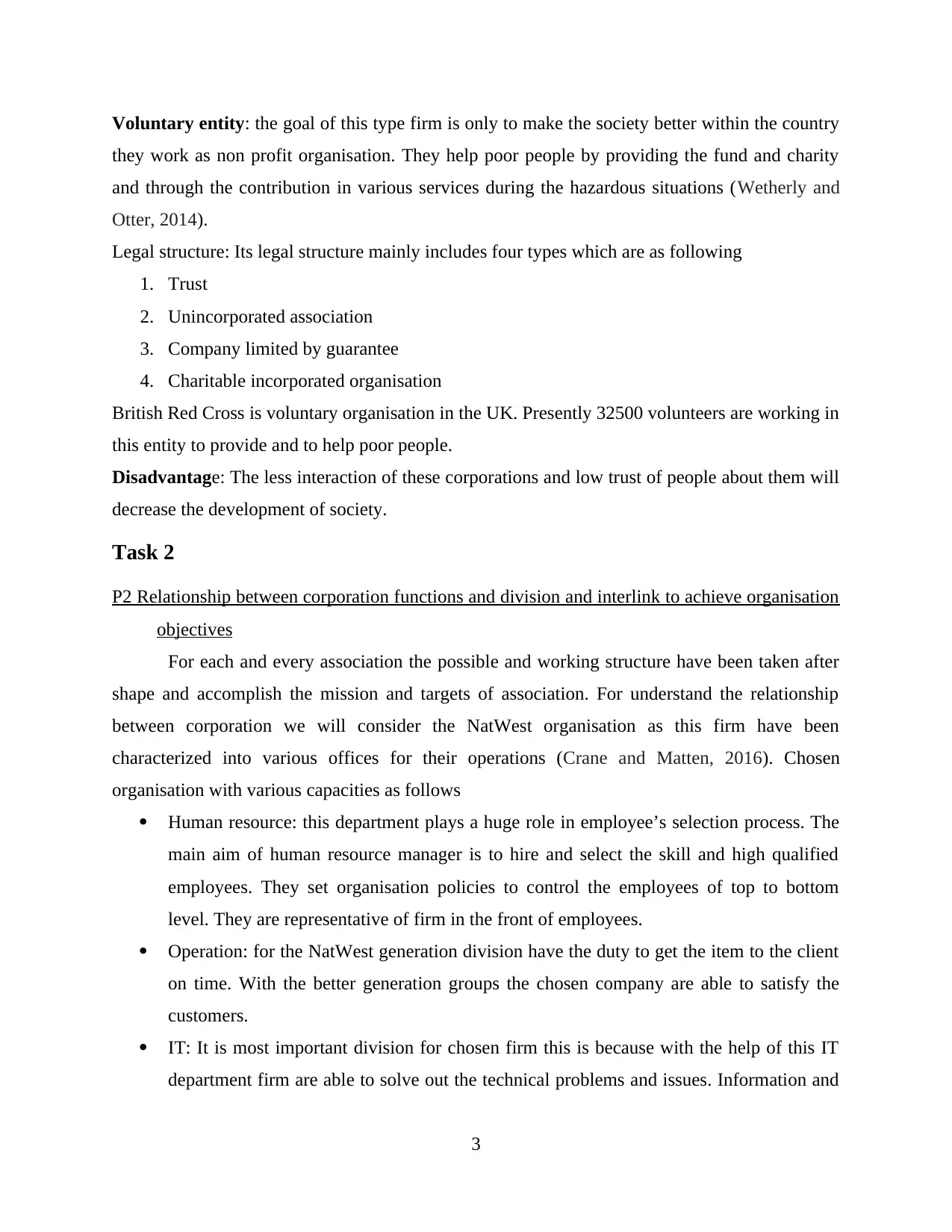
Voluntary entity: the goal of this type firm is only to make the society better within the country
they work as non profit organisation. They help poor people by providing the fund and charity
and through the contribution in various services during the hazardous situations (Wetherly and
Otter, 2014).
Legal structure: Its legal structure mainly includes four types which are as following
1. Trust
2. Unincorporated association
3. Company limited by guarantee
4. Charitable incorporated organisation
British Red Cross is voluntary organisation in the UK. Presently 32500 volunteers are working in
this entity to provide and to help poor people.
Disadvantage: The less interaction of these corporations and low trust of people about them will
decrease the development of society.
Task 2
P2 Relationship between corporation functions and division and interlink to achieve organisation
objectives
For each and every association the possible and working structure have been taken after
shape and accomplish the mission and targets of association. For understand the relationship
between corporation we will consider the NatWest organisation as this firm have been
characterized into various offices for their operations (Crane and Matten, 2016). Chosen
organisation with various capacities as follows
Human resource: this department plays a huge role in employee’s selection process. The
main aim of human resource manager is to hire and select the skill and high qualified
employees. They set organisation policies to control the employees of top to bottom
level. They are representative of firm in the front of employees.
Operation: for the NatWest generation division have the duty to get the item to the client
on time. With the better generation groups the chosen company are able to satisfy the
customers.
IT: It is most important division for chosen firm this is because with the help of this IT
department firm are able to solve out the technical problems and issues. Information and
3
they work as non profit organisation. They help poor people by providing the fund and charity
and through the contribution in various services during the hazardous situations (Wetherly and
Otter, 2014).
Legal structure: Its legal structure mainly includes four types which are as following
1. Trust
2. Unincorporated association
3. Company limited by guarantee
4. Charitable incorporated organisation
British Red Cross is voluntary organisation in the UK. Presently 32500 volunteers are working in
this entity to provide and to help poor people.
Disadvantage: The less interaction of these corporations and low trust of people about them will
decrease the development of society.
Task 2
P2 Relationship between corporation functions and division and interlink to achieve organisation
objectives
For each and every association the possible and working structure have been taken after
shape and accomplish the mission and targets of association. For understand the relationship
between corporation we will consider the NatWest organisation as this firm have been
characterized into various offices for their operations (Crane and Matten, 2016). Chosen
organisation with various capacities as follows
Human resource: this department plays a huge role in employee’s selection process. The
main aim of human resource manager is to hire and select the skill and high qualified
employees. They set organisation policies to control the employees of top to bottom
level. They are representative of firm in the front of employees.
Operation: for the NatWest generation division have the duty to get the item to the client
on time. With the better generation groups the chosen company are able to satisfy the
customers.
IT: It is most important division for chosen firm this is because with the help of this IT
department firm are able to solve out the technical problems and issues. Information and
3
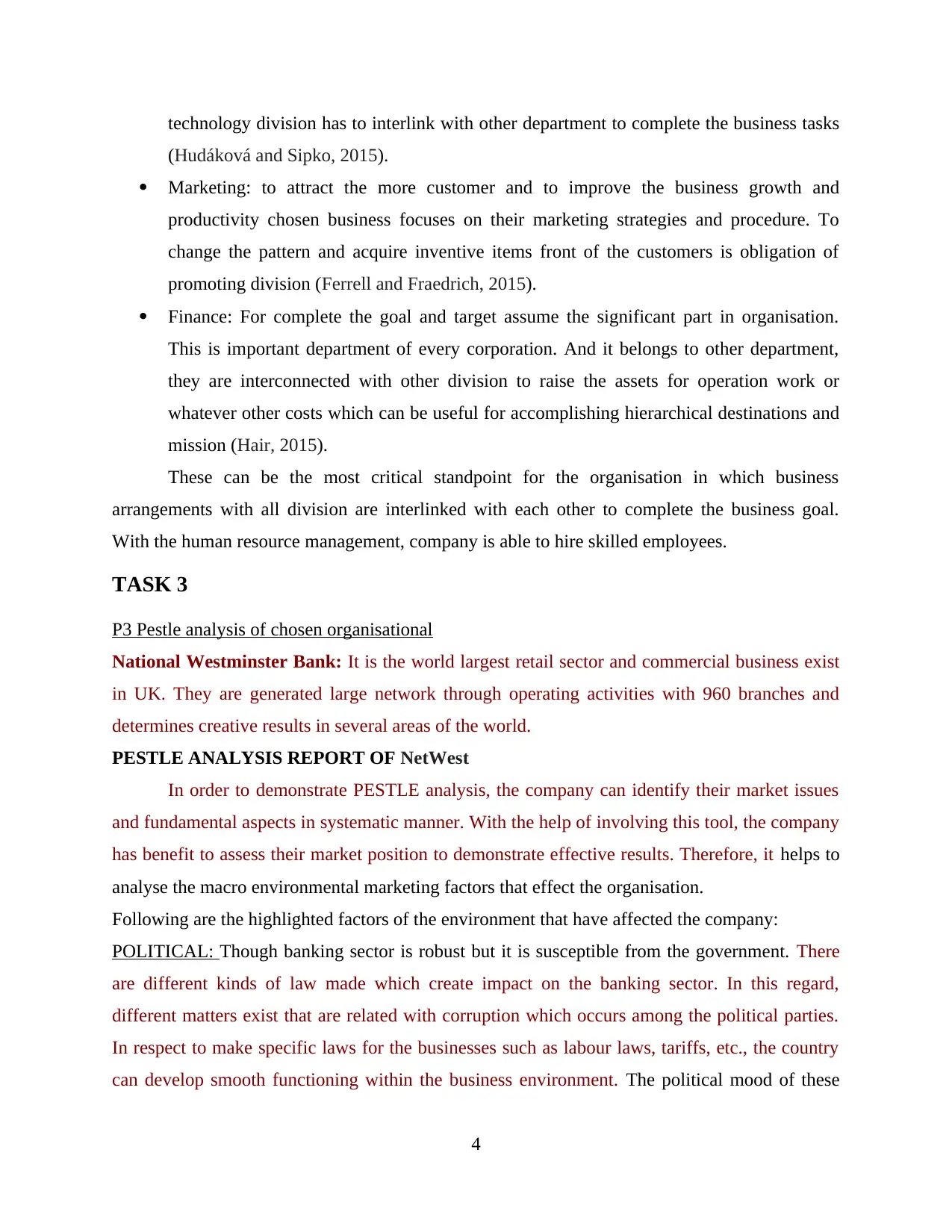
technology division has to interlink with other department to complete the business tasks
(Hudáková and Sipko, 2015).
Marketing: to attract the more customer and to improve the business growth and
productivity chosen business focuses on their marketing strategies and procedure. To
change the pattern and acquire inventive items front of the customers is obligation of
promoting division (Ferrell and Fraedrich, 2015).
Finance: For complete the goal and target assume the significant part in organisation.
This is important department of every corporation. And it belongs to other department,
they are interconnected with other division to raise the assets for operation work or
whatever other costs which can be useful for accomplishing hierarchical destinations and
mission (Hair, 2015).
These can be the most critical standpoint for the organisation in which business
arrangements with all division are interlinked with each other to complete the business goal.
With the human resource management, company is able to hire skilled employees.
TASK 3
P3 Pestle analysis of chosen organisational
National Westminster Bank: It is the world largest retail sector and commercial business exist
in UK. They are generated large network through operating activities with 960 branches and
determines creative results in several areas of the world.
PESTLE ANALYSIS REPORT OF NetWest
In order to demonstrate PESTLE analysis, the company can identify their market issues
and fundamental aspects in systematic manner. With the help of involving this tool, the company
has benefit to assess their market position to demonstrate effective results. Therefore, it helps to
analyse the macro environmental marketing factors that effect the organisation.
Following are the highlighted factors of the environment that have affected the company:
POLITICAL: Though banking sector is robust but it is susceptible from the government. There
are different kinds of law made which create impact on the banking sector. In this regard,
different matters exist that are related with corruption which occurs among the political parties.
In respect to make specific laws for the businesses such as labour laws, tariffs, etc., the country
can develop smooth functioning within the business environment. The political mood of these
4
(Hudáková and Sipko, 2015).
Marketing: to attract the more customer and to improve the business growth and
productivity chosen business focuses on their marketing strategies and procedure. To
change the pattern and acquire inventive items front of the customers is obligation of
promoting division (Ferrell and Fraedrich, 2015).
Finance: For complete the goal and target assume the significant part in organisation.
This is important department of every corporation. And it belongs to other department,
they are interconnected with other division to raise the assets for operation work or
whatever other costs which can be useful for accomplishing hierarchical destinations and
mission (Hair, 2015).
These can be the most critical standpoint for the organisation in which business
arrangements with all division are interlinked with each other to complete the business goal.
With the human resource management, company is able to hire skilled employees.
TASK 3
P3 Pestle analysis of chosen organisational
National Westminster Bank: It is the world largest retail sector and commercial business exist
in UK. They are generated large network through operating activities with 960 branches and
determines creative results in several areas of the world.
PESTLE ANALYSIS REPORT OF NetWest
In order to demonstrate PESTLE analysis, the company can identify their market issues
and fundamental aspects in systematic manner. With the help of involving this tool, the company
has benefit to assess their market position to demonstrate effective results. Therefore, it helps to
analyse the macro environmental marketing factors that effect the organisation.
Following are the highlighted factors of the environment that have affected the company:
POLITICAL: Though banking sector is robust but it is susceptible from the government. There
are different kinds of law made which create impact on the banking sector. In this regard,
different matters exist that are related with corruption which occurs among the political parties.
In respect to make specific laws for the businesses such as labour laws, tariffs, etc., the country
can develop smooth functioning within the business environment. The political mood of these
4
⊘ This is a preview!⊘
Do you want full access?
Subscribe today to unlock all pages.

Trusted by 1+ million students worldwide
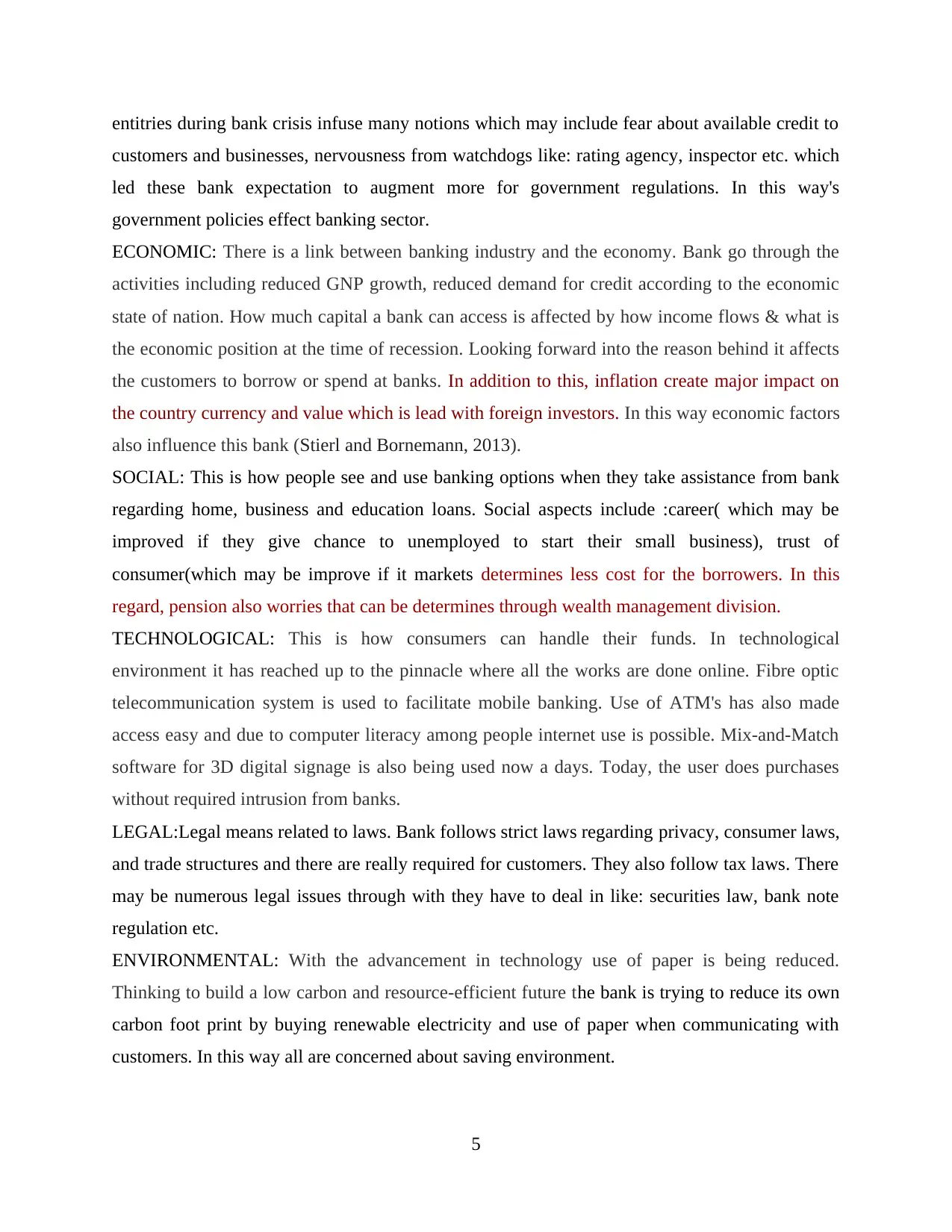
entitries during bank crisis infuse many notions which may include fear about available credit to
customers and businesses, nervousness from watchdogs like: rating agency, inspector etc. which
led these bank expectation to augment more for government regulations. In this way's
government policies effect banking sector.
ECONOMIC: There is a link between banking industry and the economy. Bank go through the
activities including reduced GNP growth, reduced demand for credit according to the economic
state of nation. How much capital a bank can access is affected by how income flows & what is
the economic position at the time of recession. Looking forward into the reason behind it affects
the customers to borrow or spend at banks. In addition to this, inflation create major impact on
the country currency and value which is lead with foreign investors. In this way economic factors
also influence this bank (Stierl and Bornemann, 2013).
SOCIAL: This is how people see and use banking options when they take assistance from bank
regarding home, business and education loans. Social aspects include :career( which may be
improved if they give chance to unemployed to start their small business), trust of
consumer(which may be improve if it markets determines less cost for the borrowers. In this
regard, pension also worries that can be determines through wealth management division.
TECHNOLOGICAL: This is how consumers can handle their funds. In technological
environment it has reached up to the pinnacle where all the works are done online. Fibre optic
telecommunication system is used to facilitate mobile banking. Use of ATM's has also made
access easy and due to computer literacy among people internet use is possible. Mix-and-Match
software for 3D digital signage is also being used now a days. Today, the user does purchases
without required intrusion from banks.
LEGAL:Legal means related to laws. Bank follows strict laws regarding privacy, consumer laws,
and trade structures and there are really required for customers. They also follow tax laws. There
may be numerous legal issues through with they have to deal in like: securities law, bank note
regulation etc.
ENVIRONMENTAL: With the advancement in technology use of paper is being reduced.
Thinking to build a low carbon and resource-efficient future the bank is trying to reduce its own
carbon foot print by buying renewable electricity and use of paper when communicating with
customers. In this way all are concerned about saving environment.
5
customers and businesses, nervousness from watchdogs like: rating agency, inspector etc. which
led these bank expectation to augment more for government regulations. In this way's
government policies effect banking sector.
ECONOMIC: There is a link between banking industry and the economy. Bank go through the
activities including reduced GNP growth, reduced demand for credit according to the economic
state of nation. How much capital a bank can access is affected by how income flows & what is
the economic position at the time of recession. Looking forward into the reason behind it affects
the customers to borrow or spend at banks. In addition to this, inflation create major impact on
the country currency and value which is lead with foreign investors. In this way economic factors
also influence this bank (Stierl and Bornemann, 2013).
SOCIAL: This is how people see and use banking options when they take assistance from bank
regarding home, business and education loans. Social aspects include :career( which may be
improved if they give chance to unemployed to start their small business), trust of
consumer(which may be improve if it markets determines less cost for the borrowers. In this
regard, pension also worries that can be determines through wealth management division.
TECHNOLOGICAL: This is how consumers can handle their funds. In technological
environment it has reached up to the pinnacle where all the works are done online. Fibre optic
telecommunication system is used to facilitate mobile banking. Use of ATM's has also made
access easy and due to computer literacy among people internet use is possible. Mix-and-Match
software for 3D digital signage is also being used now a days. Today, the user does purchases
without required intrusion from banks.
LEGAL:Legal means related to laws. Bank follows strict laws regarding privacy, consumer laws,
and trade structures and there are really required for customers. They also follow tax laws. There
may be numerous legal issues through with they have to deal in like: securities law, bank note
regulation etc.
ENVIRONMENTAL: With the advancement in technology use of paper is being reduced.
Thinking to build a low carbon and resource-efficient future the bank is trying to reduce its own
carbon foot print by buying renewable electricity and use of paper when communicating with
customers. In this way all are concerned about saving environment.
5
Paraphrase This Document
Need a fresh take? Get an instant paraphrase of this document with our AI Paraphraser
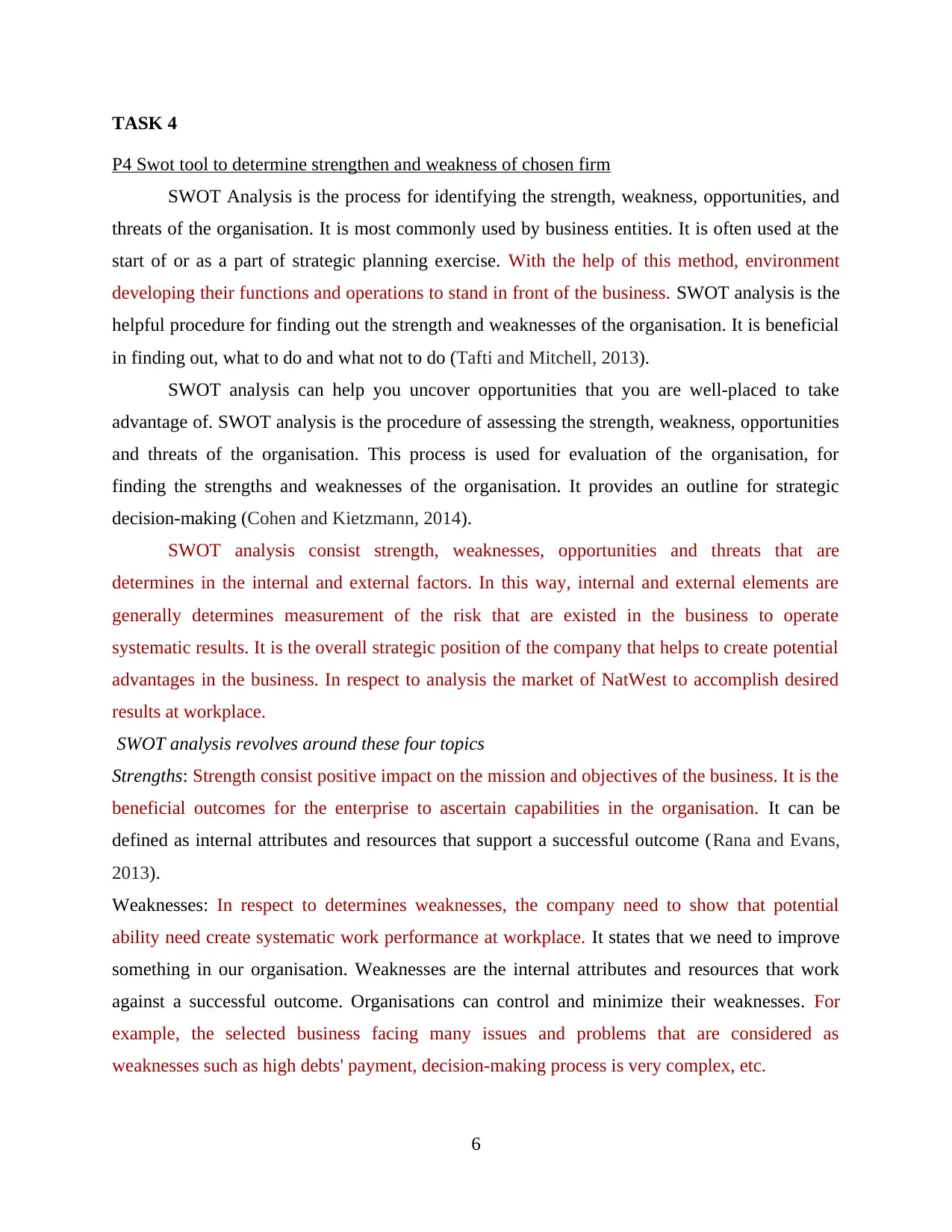
TASK 4
P4 Swot tool to determine strengthen and weakness of chosen firm
SWOT Analysis is the process for identifying the strength, weakness, opportunities, and
threats of the organisation. It is most commonly used by business entities. It is often used at the
start of or as a part of strategic planning exercise. With the help of this method, environment
developing their functions and operations to stand in front of the business. SWOT analysis is the
helpful procedure for finding out the strength and weaknesses of the organisation. It is beneficial
in finding out, what to do and what not to do (Tafti and Mitchell, 2013).
SWOT analysis can help you uncover opportunities that you are well-placed to take
advantage of. SWOT analysis is the procedure of assessing the strength, weakness, opportunities
and threats of the organisation. This process is used for evaluation of the organisation, for
finding the strengths and weaknesses of the organisation. It provides an outline for strategic
decision-making (Cohen and Kietzmann, 2014).
SWOT analysis consist strength, weaknesses, opportunities and threats that are
determines in the internal and external factors. In this way, internal and external elements are
generally determines measurement of the risk that are existed in the business to operate
systematic results. It is the overall strategic position of the company that helps to create potential
advantages in the business. In respect to analysis the market of NatWest to accomplish desired
results at workplace.
SWOT analysis revolves around these four topics
Strengths: Strength consist positive impact on the mission and objectives of the business. It is the
beneficial outcomes for the enterprise to ascertain capabilities in the organisation. It can be
defined as internal attributes and resources that support a successful outcome (Rana and Evans,
2013).
Weaknesses: In respect to determines weaknesses, the company need to show that potential
ability need create systematic work performance at workplace. It states that we need to improve
something in our organisation. Weaknesses are the internal attributes and resources that work
against a successful outcome. Organisations can control and minimize their weaknesses. For
example, the selected business facing many issues and problems that are considered as
weaknesses such as high debts' payment, decision-making process is very complex, etc.
6
P4 Swot tool to determine strengthen and weakness of chosen firm
SWOT Analysis is the process for identifying the strength, weakness, opportunities, and
threats of the organisation. It is most commonly used by business entities. It is often used at the
start of or as a part of strategic planning exercise. With the help of this method, environment
developing their functions and operations to stand in front of the business. SWOT analysis is the
helpful procedure for finding out the strength and weaknesses of the organisation. It is beneficial
in finding out, what to do and what not to do (Tafti and Mitchell, 2013).
SWOT analysis can help you uncover opportunities that you are well-placed to take
advantage of. SWOT analysis is the procedure of assessing the strength, weakness, opportunities
and threats of the organisation. This process is used for evaluation of the organisation, for
finding the strengths and weaknesses of the organisation. It provides an outline for strategic
decision-making (Cohen and Kietzmann, 2014).
SWOT analysis consist strength, weaknesses, opportunities and threats that are
determines in the internal and external factors. In this way, internal and external elements are
generally determines measurement of the risk that are existed in the business to operate
systematic results. It is the overall strategic position of the company that helps to create potential
advantages in the business. In respect to analysis the market of NatWest to accomplish desired
results at workplace.
SWOT analysis revolves around these four topics
Strengths: Strength consist positive impact on the mission and objectives of the business. It is the
beneficial outcomes for the enterprise to ascertain capabilities in the organisation. It can be
defined as internal attributes and resources that support a successful outcome (Rana and Evans,
2013).
Weaknesses: In respect to determines weaknesses, the company need to show that potential
ability need create systematic work performance at workplace. It states that we need to improve
something in our organisation. Weaknesses are the internal attributes and resources that work
against a successful outcome. Organisations can control and minimize their weaknesses. For
example, the selected business facing many issues and problems that are considered as
weaknesses such as high debts' payment, decision-making process is very complex, etc.
6
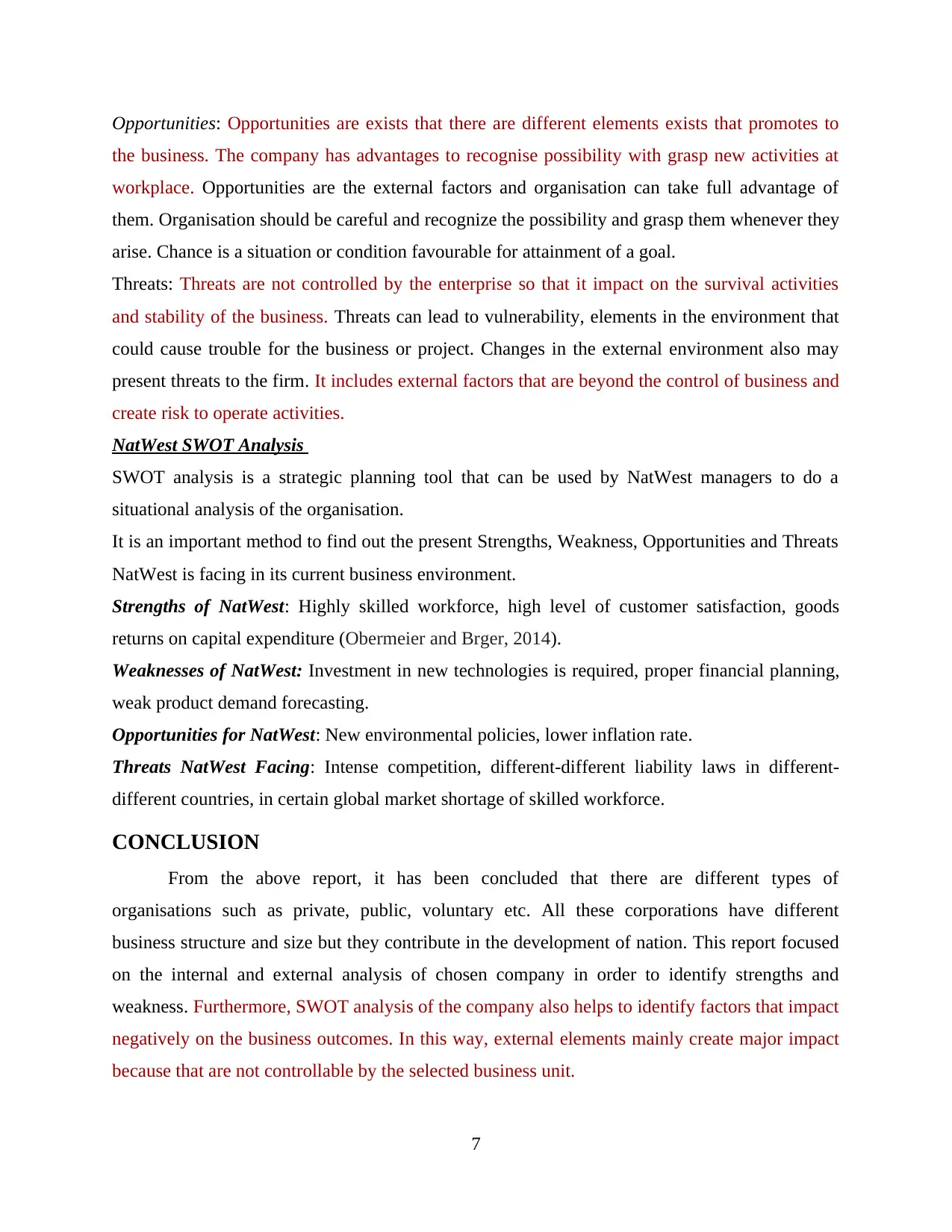
Opportunities: Opportunities are exists that there are different elements exists that promotes to
the business. The company has advantages to recognise possibility with grasp new activities at
workplace. Opportunities are the external factors and organisation can take full advantage of
them. Organisation should be careful and recognize the possibility and grasp them whenever they
arise. Chance is a situation or condition favourable for attainment of a goal.
Threats: Threats are not controlled by the enterprise so that it impact on the survival activities
and stability of the business. Threats can lead to vulnerability, elements in the environment that
could cause trouble for the business or project. Changes in the external environment also may
present threats to the firm. It includes external factors that are beyond the control of business and
create risk to operate activities.
NatWest SWOT Analysis
SWOT analysis is a strategic planning tool that can be used by NatWest managers to do a
situational analysis of the organisation.
It is an important method to find out the present Strengths, Weakness, Opportunities and Threats
NatWest is facing in its current business environment.
Strengths of NatWest: Highly skilled workforce, high level of customer satisfaction, goods
returns on capital expenditure (Obermeier and Brger, 2014).
Weaknesses of NatWest: Investment in new technologies is required, proper financial planning,
weak product demand forecasting.
Opportunities for NatWest: New environmental policies, lower inflation rate.
Threats NatWest Facing: Intense competition, different-different liability laws in different-
different countries, in certain global market shortage of skilled workforce.
CONCLUSION
From the above report, it has been concluded that there are different types of
organisations such as private, public, voluntary etc. All these corporations have different
business structure and size but they contribute in the development of nation. This report focused
on the internal and external analysis of chosen company in order to identify strengths and
weakness. Furthermore, SWOT analysis of the company also helps to identify factors that impact
negatively on the business outcomes. In this way, external elements mainly create major impact
because that are not controllable by the selected business unit.
7
the business. The company has advantages to recognise possibility with grasp new activities at
workplace. Opportunities are the external factors and organisation can take full advantage of
them. Organisation should be careful and recognize the possibility and grasp them whenever they
arise. Chance is a situation or condition favourable for attainment of a goal.
Threats: Threats are not controlled by the enterprise so that it impact on the survival activities
and stability of the business. Threats can lead to vulnerability, elements in the environment that
could cause trouble for the business or project. Changes in the external environment also may
present threats to the firm. It includes external factors that are beyond the control of business and
create risk to operate activities.
NatWest SWOT Analysis
SWOT analysis is a strategic planning tool that can be used by NatWest managers to do a
situational analysis of the organisation.
It is an important method to find out the present Strengths, Weakness, Opportunities and Threats
NatWest is facing in its current business environment.
Strengths of NatWest: Highly skilled workforce, high level of customer satisfaction, goods
returns on capital expenditure (Obermeier and Brger, 2014).
Weaknesses of NatWest: Investment in new technologies is required, proper financial planning,
weak product demand forecasting.
Opportunities for NatWest: New environmental policies, lower inflation rate.
Threats NatWest Facing: Intense competition, different-different liability laws in different-
different countries, in certain global market shortage of skilled workforce.
CONCLUSION
From the above report, it has been concluded that there are different types of
organisations such as private, public, voluntary etc. All these corporations have different
business structure and size but they contribute in the development of nation. This report focused
on the internal and external analysis of chosen company in order to identify strengths and
weakness. Furthermore, SWOT analysis of the company also helps to identify factors that impact
negatively on the business outcomes. In this way, external elements mainly create major impact
because that are not controllable by the selected business unit.
7
⊘ This is a preview!⊘
Do you want full access?
Subscribe today to unlock all pages.

Trusted by 1+ million students worldwide

REFERENCES
Books and Journals:
Drucker, P.F., 2017. The Theory of the Business (Harvard Business Review Classics). Harvard
Business Press.
Carroll, A. and Buchholtz, A., 2014. Business and society: Ethics, sustainability, and stakeholder
management. Nelson Education.
Welford, R., 2013. Hijacking environmentalism: Corporate responses to sustainable development.
Routledge.
Bryman, A. and Bell, E., 2015. Business research methods. Oxford University Press, USA.
Boons, F. and Lüdeke-Freund, F., 2013. Business models for sustainable innovation: state-of-the-
art and steps towards a research agenda. Journal of Cleaner Production. 45.pp.9-19.
Wetherly, P. and Otter, D. eds., 2014. The business environment: themes and issues in a
globalizing world. Oxford University Press.
Crane, A. and Matten, D., 2016. Business ethics: Managing corporate citizenship and
sustainability in the age of globalization. Oxford University Press.
Hudáková, M. and Sipko, J., 2015. The business environment of small and medium-sized
enterprises in selected regions of the Czech Republic and Slovakia. E+ M Ekonomie a
Management. (1). p.95.
Ferrell, O.C. and Fraedrich, J., 2015. Business ethics: Ethical decision making & cases. Nelson
Education.
Hair, J.F., 2015. Essentials of business research methods. ME Sharpe.
Tafti, A. and Mitchell, W., 2013. How a Firm's Competitive Environment and Digital Strategic
Posture Influence Digital Business Strategy. MIS quarterly. 37(2).
Cohen, B. and Kietzmann, J., 2014. Ride on! Mobility business models for the sharing
economy. Organisation & Environment. 27(3).pp.279-296.
Barnes, S. and Hunt, B. eds., 2013. E-commerce and v-business. Routledge.
Rana, P. and Evans, S., 2013. A value mapping tool for sustainable business
modelling. Corporate Governance. 13(5).pp.482-497.
Obermeier, S. and Brger, E., 2014. Subject-oriented business process management. Springer
Publishing Company, Incorporated.
8
Books and Journals:
Drucker, P.F., 2017. The Theory of the Business (Harvard Business Review Classics). Harvard
Business Press.
Carroll, A. and Buchholtz, A., 2014. Business and society: Ethics, sustainability, and stakeholder
management. Nelson Education.
Welford, R., 2013. Hijacking environmentalism: Corporate responses to sustainable development.
Routledge.
Bryman, A. and Bell, E., 2015. Business research methods. Oxford University Press, USA.
Boons, F. and Lüdeke-Freund, F., 2013. Business models for sustainable innovation: state-of-the-
art and steps towards a research agenda. Journal of Cleaner Production. 45.pp.9-19.
Wetherly, P. and Otter, D. eds., 2014. The business environment: themes and issues in a
globalizing world. Oxford University Press.
Crane, A. and Matten, D., 2016. Business ethics: Managing corporate citizenship and
sustainability in the age of globalization. Oxford University Press.
Hudáková, M. and Sipko, J., 2015. The business environment of small and medium-sized
enterprises in selected regions of the Czech Republic and Slovakia. E+ M Ekonomie a
Management. (1). p.95.
Ferrell, O.C. and Fraedrich, J., 2015. Business ethics: Ethical decision making & cases. Nelson
Education.
Hair, J.F., 2015. Essentials of business research methods. ME Sharpe.
Tafti, A. and Mitchell, W., 2013. How a Firm's Competitive Environment and Digital Strategic
Posture Influence Digital Business Strategy. MIS quarterly. 37(2).
Cohen, B. and Kietzmann, J., 2014. Ride on! Mobility business models for the sharing
economy. Organisation & Environment. 27(3).pp.279-296.
Barnes, S. and Hunt, B. eds., 2013. E-commerce and v-business. Routledge.
Rana, P. and Evans, S., 2013. A value mapping tool for sustainable business
modelling. Corporate Governance. 13(5).pp.482-497.
Obermeier, S. and Brger, E., 2014. Subject-oriented business process management. Springer
Publishing Company, Incorporated.
8
Paraphrase This Document
Need a fresh take? Get an instant paraphrase of this document with our AI Paraphraser

Stierl, M. and Bornemann, T., 2013. Corporate social responsibility in business-to-business
markets: how organisational customers account for supplier corporate social
responsibility engagement. Journal of Marketing. 77(6).pp.54-72.
9
markets: how organisational customers account for supplier corporate social
responsibility engagement. Journal of Marketing. 77(6).pp.54-72.
9
1 out of 11
Related Documents
Your All-in-One AI-Powered Toolkit for Academic Success.
+13062052269
info@desklib.com
Available 24*7 on WhatsApp / Email
![[object Object]](/_next/static/media/star-bottom.7253800d.svg)
Unlock your academic potential
Copyright © 2020–2025 A2Z Services. All Rights Reserved. Developed and managed by ZUCOL.





